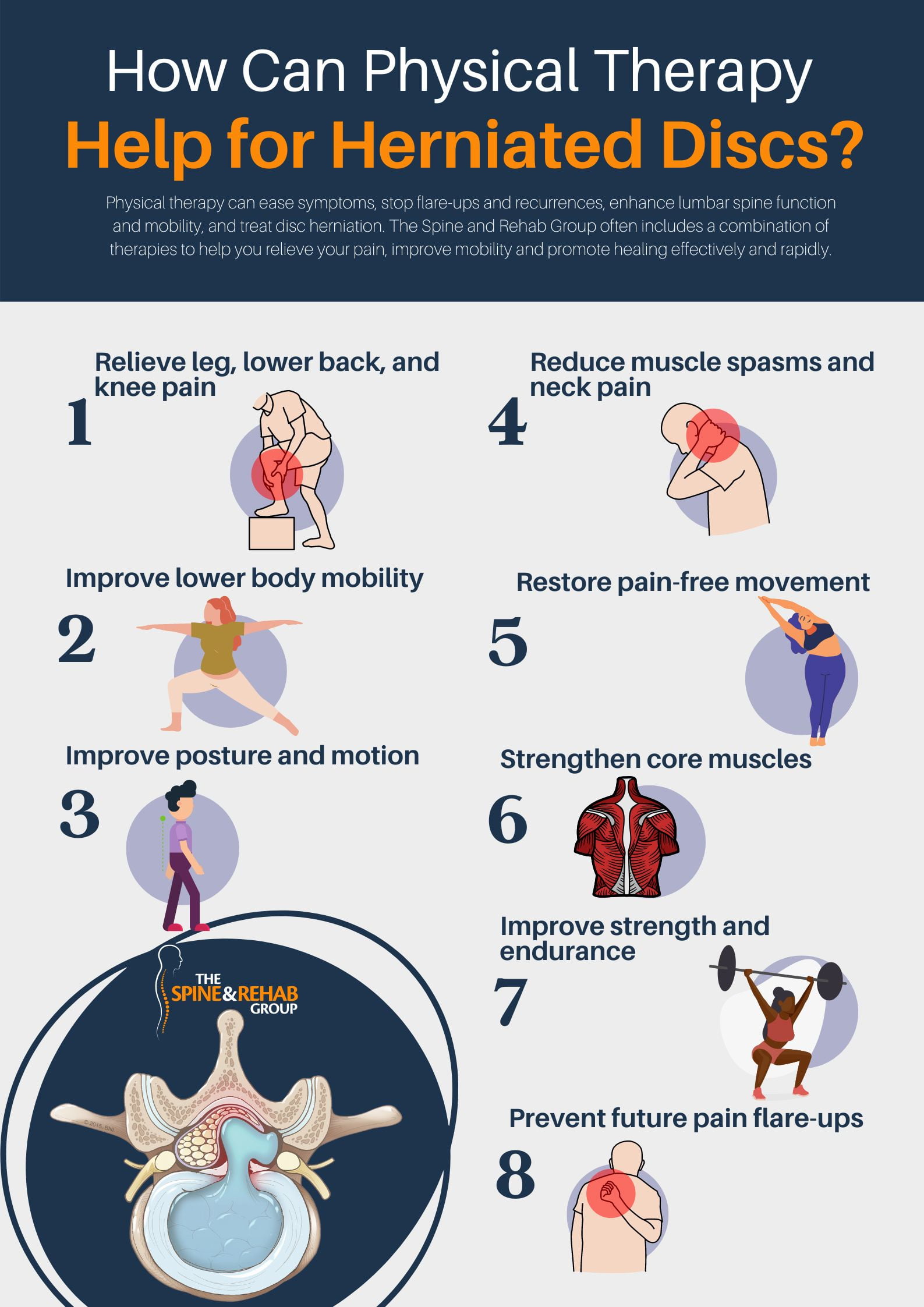 OUR LOCATIONS
Call to book 201.523.9590
OUR LOCATIONS
Call to book 201.523.9590
 OUR LOCATIONS
Call to book 201.523.9590
OUR LOCATIONS
Call to book 201.523.9590

Herniated disc is the most prevalent diagnosis among the degenerative anomalies of the spine, affecting 2% to 3% of the world population. As we age, the ligaments that keep the disc in place start to deteriorate naturally. As this degeneration progresses, a relatively minor strain or twisting movement can cause a disc to rupture. As a result of this displacement, the disc presses against the spinal nerves, frequently causing severe pain.
So can you fix herniated disc pain with physical therapy? Most types of herniated disc can be treated with physical therapy and don’t need to be surgically repaired. Physical therapy and rehabilitation programs that are dedicated to provide you relief and recovery, limit additional injury or disability, and enhance range of motion and quality of life.
A herniated disc can develop anywhere along the spine, but the lower back is where it usually occurs. Depending on where it occurs, a herniated disc may result in pain, numbness, tingling sensation or weakness in an arm or leg.
Physical therapy can ease symptoms, stop flare-ups and recurrences, enhance lumbar spine function and mobility, and treat disc herniation. The Spine and Rehab Group often includes a combination of therapies to help you relieve your pain, improve mobility and promote healing effectively and rapidly. We can help you:
We at The Spine and Rehab Group can develop a one-on-one physical therapy treatment plan customized and suitable for your needs to help you recover more quickly. Our highly-trained physical therapists will make your treatment our primary focus and your recovery our primary goal.

Once your doctor has determined that you have a herniated disc and that therapy is necessary to treat the disease, it’s critical to locate a physical therapist with experience treating patients with this particular problem. Usually, a physical therapist with expertise in either orthopedics or neurology will be able to assist patients with a herniated disc.
At The Spine and Rehab Group, our team of highly-trained physical therapists and physical therapy treatments are overseen by a group of Board Certified Medical Doctors. Our therapists are among the best physical therapists. We offer a wide range of integrative physical therapy techniques and review each case to determine the best course of action tailored to meet your needs.
Once you are enrolled in our physical therapy program, you will be given exercises that attempt to relieve pressure on any compressed nerves based on your directional preferences. Exercises for the core are then frequently advised to assist stabilize the spine. The addition of aerobic training improves your endurance. Finally, our physical therapists will help you become more flexible by stretching and performing manual work.
Physical therapy may temporarily relieve specific symptoms during the acute stages of a disc herniation, but it may take some time before the condition is significantly and permanently improved. When compared to surgery three months later, physical therapy, pain medication, and information about your diagnosis have generally been found to be just as successful in managing lumbar disc herniation.
Typically, passive therapies will be used to start your physical therapy program. However, after your body has recovered, you’ll begin active therapies that will strengthen your body and prevent further discomfort. Our physical therapist will create a strategy that includes your involvement and will be thoroughly tested to see if it works for you.
Passive treatments relax your body. Patients are not required to actively participate in this treatment. This includes:
This is the best choice since it applies a lot of pressure to release deep muscle tension and spasms, limiting muscle action in the affected area.
Our physical therapist may alternate between hot and cold therapies to achieve the best outcome.
Our physical therapy program applies heat to promote blood flow to the affected area. Blood brings more oxygen and nutrients to the area, aiding in healing. Blood also flushes out waste materials produced by muscle spasms.
On the other hand, cryotherapy, often known as cold therapy, inhibits circulation. This lessens pain, inflammation, and muscular spasms.
This is administered passively by simply relaxing in a warm shower or whirlpool bath. Hydrotherapy helps muscles relax and gently alleviates pain.
A TENS machine stimulates your muscles with an electrical current. Key locations along the nerve system receive a small electrical current from electrodes taped to your skin. Electrical stimulation lessens muscle spasms and is widely thought to cause the body’s natural painkillers, endorphins, to be released.
It reduces the adverse effects of gravity on the spine. This can lessen the disc herniation by carefully pushing apart the bones.
Active treatments help with joint movement, flexibility, posture, strength, and core stability. To get the best effects, our physical therapist will teach you strengthening, stretching, and pain-reduction exercises to perform at home. This will improve your general health in addition to reducing chronic pain.
The muscles supporting the spine will become stronger through gentle exercises and activities, which will also relieve pressure on the spinal column. Additionally, they will assist the spine in becoming more flexible and may lessen the likelihood of a slipped disc from recurring.
You should perform these therapeutic exercises 3 to 5 times weekly for three weeks to reap the most significant benefits.
Stretching and exercise are excellent ways to manage a herniated disc, but using too much power can worsen the condition and cause further harm. Pay attention to your body as you go more slowly. Contact our Board Certified Doctors immediately if engaging in physical activity causes you to experience more pain or other symptoms (such as numbness or weakness).
Surgery may be required in severe lumbar disc herniation cases to prevent long-term neurological impairment. Surgery may be required if non-surgical options are unsuccessful in relieving the discomfort. Even so, the surgeon can still advise physical therapy following the surgery.
Physical therapy continues to be important for post-operative recovery since it speeds up the process and helps with post-operative pain management. Additionally, it enables our physical therapist to give post-operative instructions on proper movement forms to lower the risk of disc herniation and other potential consequences.
According to research, beginning exercise as soon as feasible following lumbar spine surgery helped patients recover more quickly and function normally. According to additional research, starting to walk within a week of surgery has benefits that last for months after the procedure, as opposed to staying on bed rest.
The spine needs to be retrained to stay steady while you stand or sit up straight after surgery. Stabilization exercises can benefit patients after surgery in this situation. These exercises might assure faster recovery by lowering discomfort and enhancing spine movement.
Although surgery may temporarily lessen discomfort more, there is a higher risk of herniation recurrence and persistent low back pain, which frequently necessitates another surgery.
Consult our highly-skilled physical therapists if you’ve been dealing with lumbar disc herniation discomfort and wish to avoid surgery. We will not only assist you in getting rid of your pain and returning to your active way of life, but we will also show you how to keep your back healthy by preventing further injuries.
Even the most basic tasks can feel nearly impossible if a herniated disc treatment is neglected. This is because untreated herniated discs can cause severe, stabbing sensations, partial paralysis, or, in more extreme cases, the inability to control bowel movements. Even if your herniated disc may never reach that stage, you don’t have to take that chance.
At The Spine and Rehab Group, our back specialists provide thorough diagnostic services to identify the precise cause of your low back pain, enabling us to create a treatment strategy that effectively addresses the issue at its source. Experience spinal care unlike any other – schedule your appointment with us today.



